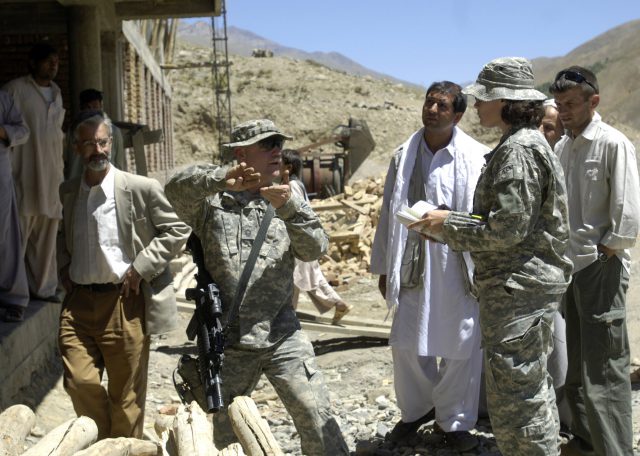
Military engagement and post-conflict reconstruction are impossible to disentangle. Modern firepower means that even short wars can leave widespread devastation—shattered cities and infrastructure, dysfunctional institutions and weakened social and political structures.
Also, contemporary warfare rarely produces a decisive victory and final peace settlement. Instead, it generates a stabilisation phase involving violence and insurgency, with fragile peace arrangements at risk of disintegration. Military engagement and reconstruction are two sides of the same coin with interdependent objectives. Peace cannot be maintained without reconstruction, but reconstruction is impeded by ongoing conflict.
Australia has contributed to reconstruction in a combat or peacekeeping role from Timor Leste and Cambodia to Afghanistan and Iraq. New scenarios are emerging from Syria to Mindanao. The stabilisation element of reconstruction is now part of the ADF’s core business.
Reconstruction is costly. The Lowy Institute estimated that the Regional Assistance Mission to the Solomon Islands cost A$2.6 billion. The 2018 Kuwait donor conference estimated that US$88 billion would be required for Iraq. Preliminary estimates in Syria exceed US$100 billion.
Reconstruction is a massive organisational challenge. Physical damage may be catastrophic, communities confused and disoriented. Refugees may demand resettlement despite the lack of housing, food, water and employment. The threat of infectious diseases is constant. The possible resurgence of warfare looms over everything.
A reconstruction plan is critical and it must set out priorities and approaches while retaining a capacity to respond to a volatile milieu. It must identify, at least broadly, how goals will be achieved. A wish list of objectives isn’t a plan.
Reconstruction is fraught with contradictions, including competing timeframes. It takes years or decades, yet it’s also a race against time. Need is pressing, delay measured in human life and poor welfare.
Deciding on a program structure involves crucial choices between breadth and depth. Progress in one area of an economy may be constrained by a lack of progress elsewhere. A broad program can have small effects across a wide front, but lack the larger effects of a more intensive, focused approach. Tokenism risks producing fragile results, soon eroded.
Post-conflict situations make community consultation difficult. The population may be in shock or displaced, and its leaders killed or exiled, making it difficult for communities to identify and articulate priorities or preferred approaches. Nevertheless, conditions demand major decisions, some with long-term implications.
Civil–military cooperation is a new frontier. They may be reluctant partners, but in reconstruction they need to work together. Cooperation can’t be left to a small coordinating group. It needs to encompass the awareness, mindset and behaviour of the staff of all parties at headquarters and in the field.
War is a nightmare for many, but a business opportunity for some. The urgency of reconstruction makes corruption difficult to contain. Forcing large amounts of money, people and materiel through a weakened economy means decisions are made on the run and accountability struggles to keep up with activity. Often, corruption is widespread locally and its practice an art form, leaving any weak links in the supply chain vulnerable.
For reconstruction to be effective, planning should commence as early as possible, not when hostilities cease. Information about what’s likely to be required can be gathered at low cost during conflict so that decisions can be made quickly when circumstances permit.
Normality must be restored as quickly as possible: schools re-opened, markets functioning and clinics providing treatment, even if imperfectly. This reduces community frustrations and social tension. Initial projects need to begin quickly. They can be small, but must be visible.
Reconstruction can’t happen overnight and funding must continue for years, perhaps decades. However, the global caravan moves on as new emergencies arise. Past commitments to long-term support are quickly forgotten. This can cause simmering political and security situations like those in Afghanistan and Iraq.
Failure of reconstruction prolongs military engagement, which then delays reconstruction. For reconstruction to succeed, this cycle must be broken.
While the principal reconstruction effort will rightly take place in secure zones where impact is greatest and risk to personnel low, operations in contested areas are essential, both on humanitarian grounds and to reinforce the practical advantages of supporting a peace settlement.
Although it can be costly, the preservation of a community’s heritage creates a sense of cultural continuity and social cohesion. Combatants have targeted cultural sites, especially in the Middle East. Preventing that will be critical in Syria, where a diverse ethnic and religious community is bound together in part by a shared heritage.
Lessons are being learned quickly from reconstruction operations. It’s become clear, for example, that hiring local staff and contractors restores employment, creates income and rebuilds businesses. Costly expatriates can be used for coordination and training. Many agencies use direct cash payments to individuals or households, enabling them to determine their own purchasing priorities and providing a market for local suppliers.
The US Special Inspector General in Afghanistan, as well as NATO and the World Bank, are already codifying skills and distilling lessons from experience.
Technology can improve efficiency, for example with satellite monitoring of ground conditions, small-scale units for energy generation and water purification, and mobile phone coverage to enable affected communities to receive reports and communicate with each other.
The UN slogan ‘build back better’ exhorts the global community to replace infrastructure damaged in disasters or conflict with superior facilities even when that’s at odds with financial realities. Arguably, the most important trend in post-conflict reconstruction is strengthening the ability of local communities to mobilise themselves to meet their own needs using limited technical advice and external funding.
The challenge is to do more with less without compromising economic, political and security objectives. This will test everyone.

